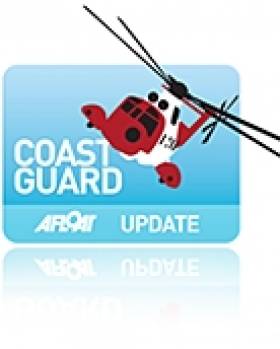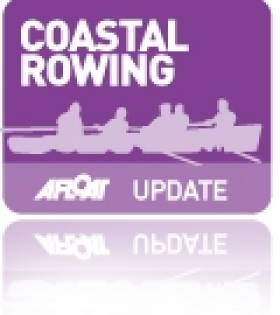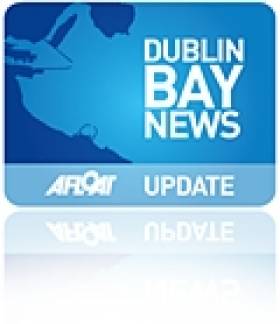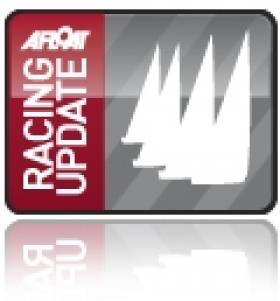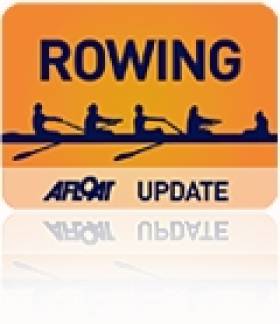Displaying items by tag: Irish
Search Continues for Six Seafarers Missing on the Irish Sea
#RESCUE–Holyhead Coastguard is currently coordinating the search for six merchant seafarers who are missing in gale force weather 10 miles west of the Lleyn peninsula, Gwynedd.
The 81-metre cargo carrier, 'Swanland' broadcast a mayday message at 2.00 am this morning. The ship reported that their hull was cracking, due to bad weather and that they thought that it may be taking water. Holyhead Coastguard broadcast a mayday relay and several vessels responded. Two of these vessels were able to go to the assistance of the Swanland and its eight crew. When the two vessels arrived at the scene, they found two liferafts and some floating debris. They were able to provide shelter from the gale force winds, whilst awaiting the arrival of rescue resources. Meanwhile Holyhead Coastguard had scrambled the two rescue helicopters from RAF Valley and Dublin Coastguard and requested the launch of the Pwllheli and Porth Dinllaen RNLI all weather lifeboats.
When the helicopters arrived on scene they found two crew members in the water clinging to the liferafts. These two were airlifted from the sea into the RAF helicopter and taken to RAF Valley. The search is continuing for the other six. The original two helicopters have now been replaced with a helicopter from RAF Chivenor and an Irish Coastguard helicopter.
Holyhead Coastguard Watch Manager Jim Green says:
"We are very concerned for the safety of the other six crew members. We know that at least some of them are wearing immersion suits and have strobe lighting with them, however sea conditions are challenging at best.
The cargo vessel had 3000 tonnes of limestone onboard. It appears that it may have sunk."
ISORA 2012 Looking at Trackers and 'Virtual' Marks
The moves come as the offshore body goes from strength to strength on the Irish Sea, recruiting more boats to venture out of Dublin Bay and to try longer distance races. It is a reversal of fortunes for offshore sailing that had been vitally wiped out just a few years ago.
The idea for the new marks sprung from last years' Lyver Race from Liverpool Yacht Club where a virtual mark was successfully used as a mark on the course (i.e. coordinates only).
The problem for ISORA though, with the exception of M2 buoy, is most of the marks used in ISORA raeces are within five to seven miles of the Irish coast and there are no marks off the Welsh coast.
Using virtual marks further off the coast would greatly help in setting courses that are not just long reaching legs. The day races, particularly from Dun Laoghaire could be far more interesting.
One of the problems about using the virtual marks though is the question of "how do you ensure that all boats have rounded the mark?"
The boats in the Lyver race had trackers fitted but ISORA commodore Peter Ryan says his experience of watching several boats round the 'mark' was that they tended to take it 'wide'.
Ryan is looking into the possibility of "obtaining" a set of trackers that could be used for all ISORA races.
Another suggestion is that a photograph could be taken on a mobile phone of the boat's GPS display at the time of the rounding. The photo would then be sent by SMS to the race office as part of the normal finish time declaration.
The feasibility of such a move is just one of the items on the agenda at the association's agm on November 19th at the National Yacht Club in Dun Laoghaire, a highlight of the offshore year.
Irish crews had a good first day at the Fisa World Coastal Rowing Championships in Bari in Italy. John Keohane, who is defending his crown in the men’s single, qualified through the heats for tomorrow’s A Final, as did Monika Dukarska and Sheila Clavin in the women’s single. The men’s coxed quadruple from Kilmacsimon saw their hopes disappear in an instant when their bowman broke an oar in their heat. They came home down the field with just three men rowing, but went on to win their C Final last evening.
Fisa World Coastal Rowing Championships, Bari, Italy Day One
Men
Quadruple, coxed – Heat Two (1-8 to A Final; 9-16 to B Final; rest to C Final): 1 Bayer Leverkusen, Germany 20:55.60; 18 Kilmacsimon (S Bennett, S O’Neill, K O’Dwyer, E O’Neill; K O’Leany) 27:56.60. C Final: 1 Kilmacsimon 26:03.50.
Double – Heat Two (1-6 to A Final, 7-12 to B Final; 13-18 to C Final; rest to D Final): 1 Elpis Genova, Italy 21:45.80; 14 Kilmacsimon (D O’Donovan, R Farrissey) 30:48.00. C Final: 6 Kilmacsimon 31:30.70.
Single – Heats (1-8 To A Final; 9-16 to B Final; rest to C Final) – Heat One: 1 Trieste, Italy (S Martini); 11 Arklow (E Kavanagh). Heat Two: 1 Cus Pavia, Italy 24:34.90; 6 Kilmacsimon (J Keohane) 25:24.60.
Women
Double – Heats (1-6 to A Final; rest to B Final) – Heat One: 1 Aviron Hennebont, France 26:23.50; 8 Arklow (D Maghery, Y Jordan) 34:04.30. Heat Two: 1 Aviron Grenoblois, France 26:47.10; 8 Kilmacsimon (H O’Neill, L O’Neill) 38:15.20.
Single – Heats (1-6 to A Final; rest to B Final) – Heat One: 1 Murcarolo, Italy 30:20.60; 3 St Michael’s (S Clavin) 33:12.50, 8 Arklow (J Ni Ghormain) 39:02.00. Heat Two: 1 Societe Nautique D’Avignon 29:19.90, 2 Killorglin (M Dukarska) 30:38.90; 8 Arklow (J Lee) 42.01.80.
Sharkbait Wins By a Single Point at SB3 National Championships
The young pretender Ross Vaughan RNIYC took line honours in race one. But it was the experience of 1988 and 1992 Olympian Peter Kennedy who lead after day one with two wins. Hot on his heels going into Saturday were top Irish performer at this year's worlds, Mel Collins of RCYC sailing Sibelus, and last year's Champion Gareth Flannigan from Ballyhome YC.
Day two which ended up as the final day, included the first two races in the north of Dublin Bay. Jack Roy moved the fleet towards Dalkey Island for the final race.
A second place by RIYC Alan McGettigan's Defiant in race four skippered by Colin Galavan, was the hosts club best result over the weekend. Andrew Algeo sailing Flutter was best placed Dun Laoghaire boat with some very consistent results finishing sixth overall.
But it was Sharkbait sailed by Ben Duncan, Brian Moran & Ric Morris representing Howth YC who prevailed with some excellent results. Including two wins and two seconds brought them over the finishing line to win from Ridgefence by one point. The Howth team sailed superbly all weekend and thoroughly deserved their victory.
"This was a very well run regatta by Paul McCarthy RIYC and Mark McGibney sailing manager.
Another very successful year for the SB3 class, with 39 entries for our Nationals, and the quality throughout the fleet, making it the most competitive class on the island " said Jerry Dowling, SB3 National Chairman and organiser of this year's National Championship.
The last SB3 Regatta is the Midlands hosted by Lough Ree YC 15 -16 th 2011.
Dun Laoghaire Yacht Clubs Voice Concern Over Plan
Dun Laoghaire Yacht Clubs are voicing concerns about the impact on sailing if a 'cruise ship jetty' is constructed as part of the recently published harbour masterplan.
Dublin Bay Sailing Club, Dun Laoghaire Motor Yacht Club, National Yacht Club, Royal Alfred Yacht Club
Royal Irish Yacht Club and Royal St George Yacht Club. are also concerned about access to the water if a proposed 'pedestrian walkway' in front of the waterfront clubs was completed.
The clubs have engaged 'professional help' to prepare a submission to outine the concerns.
Also seen as a problem is the 'lack of sufficient facilities in the masterplan for hosting significant international sailing events'.
A survey in 2009 by the Irish Marine Federation (IMF) calculated a €3million spend by participants connected with the 500-boat Volvo Dun Laoghaire regatta. The clubs have previously stated they see the harbour's future as a leisure facility.
A masterplan model was on display by the Harbour Company in the month of August.
Writing to members in the current edition of the National Yacht Club's newsletter commodore Paul Barrington says the clubs 'hope to further engage with the harbour [company] to find a mutually acceptable way forward'.
Water Rat: Harbour Plan is a Curate's Egg
Royal Irish Yacht Club Celebrates 180th Birthday
MGM Boats Put a Boating Swing into the Irish Open
Leading Irish boat dealer MGM Boats Ltd is playing golf this weekend. While the Dun Laoghaire firm may not be teeingg off in Killarney, Gerry Salmon, Martin Salmon anf Joe Hill are on the course as the Irish Distributors of Sunseeeker boats, an official sponsor of the Irish Open Golf Tournament 2011.
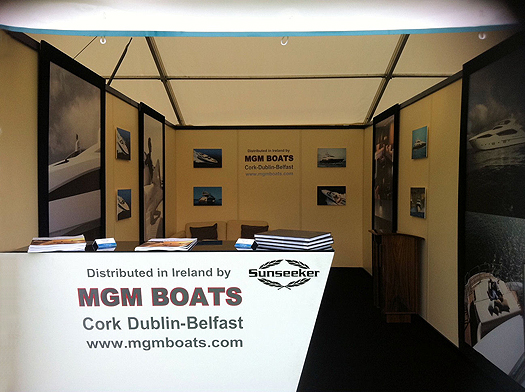
The event is held at the Killarney Golf and Fishing Club 28th to 31st July. MGM Boats Have a stand in the Tented Exhibition Area area and also have a Sunseeker XS Sport on Display. The Salmon's are in attendance for the duration of the event.
Racing Round Up - Weekend Irish Sailing Review
Quadruple Misses Out on Semi-Final in Amsterdam
Ireland’s men’s lightweight quadruple scull failed to join the two women’s crews in the semi-finals of the World Under-23 Rowing Championships in Amsterdam. The crew of Shane O’Driscoll, Niall Kenny, Peter Hanily and Justin Ryan could only finish fifth in their repechage, where the top three qualified. Denmark and Switzerland headed the field, with Poland finishing well to take third. Britain were fourth and are set for the B Final alongside Ireland.
Lightweight single sculler Jonathan Mitchell finished third in his C/D semi-final and qualified for the C Final (places 13 to 18).
World Under-23 Rowing Championships, Day Three (Irish interest)
Men
Lightweight Quadruple Scull – Repechage Two (First Three to A/B Semi-Finals; rest to B Final): 1 Denmark 5:54.81, 2 Switzerland 5:56.16, 3 Poland 5:57.97; 4 Britain 6:00.23, 5 Ireland (S O’Driscoll, N Kenny, P Hanily, J Ryan) 6:04.17, 6 Austria 6:08.25.
Lightweight Single Scull – Quarter Final Four: 1 United States (A Campbell Jr) 7:11.51, 2 Greece (P Magdanis) 7:14.64, 3 Peru (R Leon Garcia) 7:20.45; 4 Ireland (J Mitchell) 7:33.62, 5 Iraq 7:40.79, 6 Armenia 8:00.14. C/D Semi-Final (First Three to C Final): 1 Chile 7:18.31, 2 Sweden 7:19.38, 3 Ireland (Mitchell) 7:19.99.
Women
Lightweight Double Scull – Repechage (First Three to A/B Semi-Finals): 1 Ireland (S Dolan, C Lambe) 7:24.04, 2 Romania 7:24.63, 3 Italy 7:26.92; 4 Czech Republic 7:35.46, 5 Tunisia 8:00.09.
Single Scull – Repechage (First Three to A/B Semi-Finals): 1 The Netherlands (N Beukers) 7:45.46, 2 Ireland (L Dilleen) 7:45.81, 3 Greece (A Nikolaidou) 7:52.71; 4 Latvia 8:06.32, 5 USA 8:11.64.



























